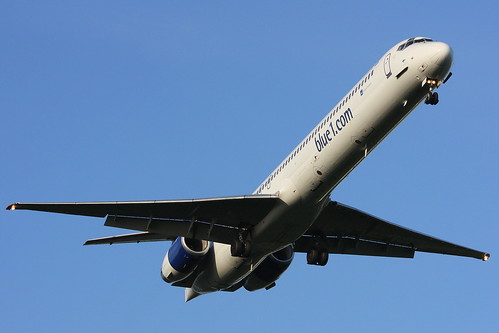
Behold! The McDonell Douglas MD-90! One of the more beautiful commuter planes in service. Swept back wings and a long fuselage, it looks faster and sleeker than, let's say, a Boeing 737. Although its small frame limit it to interstate-ferrying chores, it is a pleasant sight to the eyes. Unless you're holding tickets destined to the back, that is. (Letsee...60a, that's down the hall next to the engines! Have a nice flight!)
But it has a fatal flaw.
January 31, 2000, Alaskan Airlines flight 261 is heading to Seattle from Puerto Vallarta, Mexico at 1:37 pm Pacific Standard Time. The jet is a McDonnel Douglas MD-83, a shorter version of the MD-90. Two hours into the flight, the pilots radioed Maintenance about a jammed Horizontal Stabilizer. The horizontal stabilizer is the triangular piece attached to the tail. It controls the up-and-down movement of the plane in conjunction with the ailerons; it points the nose up and down. In that time, the pilots had to pull on the yoke firmly to maintain steady flight. They tried to 'unstick' the stabilizer by moving its control lever back and forth and back again. As they slowed to approach Los Angeles for an emergency landing, the plane suddenly nosedived, dropping 18,000 feet into the water in 81 seconds. No one survived.

Spin the nut, it goes up or down.
Why? The pretty design, that's why. The beautiful, delicately balanced T-tail's mechanism failed. The stabilizer is controlled by a mechanism called a Jackscrew. It looks and functions similarly to the height adjustment in those cheap Ikea chairs. Spin the nut clockwise to go up, counter to go down. It works the same way on the plane. The jackscrew is an intrinsically safe design; what caused the crash was Alaskan's fault. They neglected to lubricate the jackscrew mechanism within the manufacturer's specification so the nut started shearing the thread until the now-threadless screw flew out of the assembly. Alaskan flight 261 crashed with a vital stabilizer flailing in the wind. It pinned the nose down with enough force to break the ailerons off.

That piece on top of the tail is the stabilizer. Now imagine it flapping uncontrollably in the wind.
So, that' the gist. How the hell does this relate to us designers who haven't touched a physics textbook in three years(Speaking for myself...)? It's all ethics. Any other commuter plane out there will maintain stable flight in the event of catastrophic mechanical failure, hell, the Boeing 767 could fly and land with no engines and only vital instruments (Look up Gimli Glider if you're interested in this stuff). Granted, the screw flying out of its assembly might have been beyond estimated design constraints, but it is possible with neglected maintenance. As designers, we have to be aware of possible implications brought about by our designs. No matter how fail-proof we think it is, it's probably not. (And if I claim to be a wise man, it surely means that I don't know...) Our stuff have just as much impact as the engineer's stuff, and we should be aware of the responsibilities we also carry.
That, or I just wanted to share this story which I believe everyone should love!

No comments:
Post a Comment